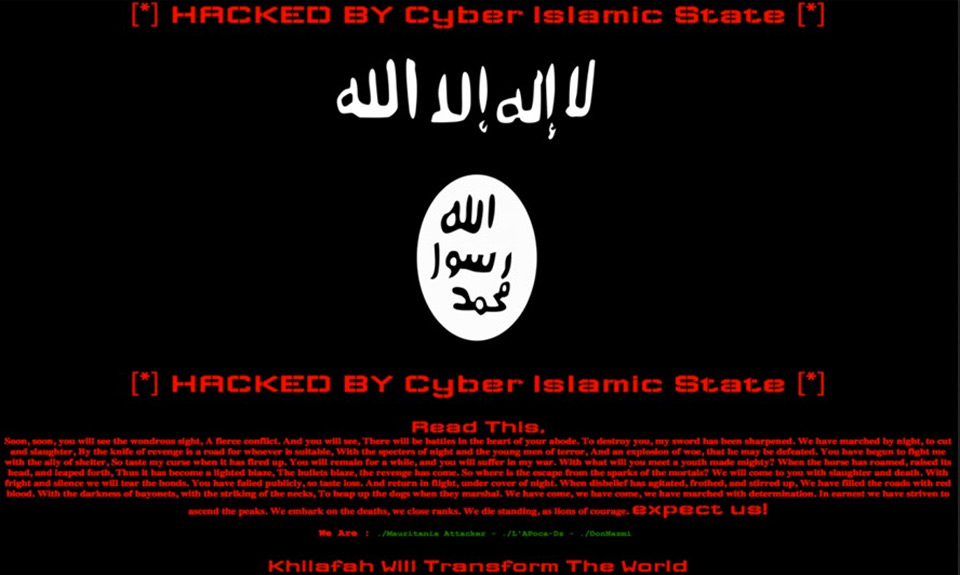The media strategy of the self-styled “Islamic State” is both effective and successful. Their professional use of social media has allowed ISIS to project a coherent image of its world while at the same time resisting “alternative narratives” against the group. Videos are published on an almost daily basis as, in addition to the execution videos, the group produces real films designed to demonstrate the state-like nature of the organization and the reconstruction of its infrastructures.
The Islamic State distributes a powerful mix of narratives conveyed through images and bound to a corpus of written texts from various sources which are the result of thirty years of jihadism. By creating a “state” (in Arabic: dawla) and making the borders between Syria and Iraq inexistent, it has achieved something Al-Qaeda had been trying to do for years: to erode borders and set up a “state” based on extremist theological interpretation.
ISIS embodies the “new AQ” by putting into practice the Qaeda ideology within the Sunni Arab stronghold territories of Syria, Iraq and a vast area between Libya, Sinai and Yemen. Consequently, the majority of foreign fighters within ISIS are Arabs and the vast majority of ISIS videos are in Arabic for reasons of propaganda and proselytism, but also because they seek to unify the extremist Arab fringes.
By transmitting videos of a physical “Islamic State”, ISIS presents a positive image of their world which offers a clear, video-recorded vision of a “Sunni Muslim identity” and uses Arab and non-Arab fighters for its multi-media productions to launch the image of this “state”.
In their efforts to achieve an accurate interpretation of this new phenomenon, Western observers have to deal with two fundamental obstacles, not only to understanding and contrasting it from a media perspective (against the propaganda and proselytism) but also regarding decisions on which strategies to use to fight back.
On the one hand ISIS appears to be a “liquid state” without the clearly defined borders, logistical objectives and infrastructures on which to base a precise and traditional military strategy. Up until the war in Afghanistan, the West had always had to face two types of enemy; foreign enemies from clearly identifiable national or regional territories and internal enemies from terrorist groups with a hierarchical structure. This division of the “enemy” has produced
two different methods of defense. In the first case, military intervention typical of national wars with clear bases and clearly identified borders and regions and in the second, intensive undercover intelligence work aimed at identifying the group’s members, tracing their money/arms/supplies/logistics channels and, after mapping the network, doing whatever necessary to destroy it.
However, these two models on which our defenses are based have now been rendered completely obsolete. The absence of borders and the huge extension of the regional areas involved makes traditional military intervention totally impracticable . Moreover, the cell based Qaeda organization which has evolved from thirty years of experience and benefited from technological developments, makes the work of counter-intelligence extremely complex. This is principally because it differs from the terrorist models and methods used in the past, but is also due to the issue of “internal terrorism”.
ISIS, however, is not simply a terrorist organization. Its communications and propaganda do not simply send out a message, create converts or identify an enemy to combat. What ISIS is really proposing, communicating and in some way “selling” to the Muslim community is the realization of a much greater aim; the constitution of a real, enormous nation-state based on extreme Islamism and a precise interpretation of the Koran and Sharia law which, up until Bin Laden, was essentially propaganda manipulated by a minority and limited to a tribal level.
Proof of this aim- should the numerous videos and documentaries on the “life” of the Islamic State not suffice- has recently been provided by two documents supplied by an Arab businessman. As the Guardian has confirmed, they contain the blueprint of the central and regional organization and institutions of ISIS, a sort of starting point on which to base the structure of institutional roles and the workings of the bureaucratic, administrative, fiscal and judicial systems.
The implicit, as well as explicit, message of this organizational plan is as simple as it is devastating; it seeks to offer an alternative model to the so far dominant Western vision of the world. Instead of the proposal for Muslims to live in poor Arab countries, frequently pro-Western if not under the direct control of the West, or to be integrated into westernized secular states, today ISIS proposes territorial independence with the foundation of an extremist religious (or simply “orthodox”) model which is, above all, independent and self-determining.
This new call to arms can no longer simply be defined as a jihad (literally, commitment) to the “fight against” – which has had its importance- but this time it becomes a “fight for” the construction of a dreamed of, longed for and highly desirable model according to ISIS theology.
This breakthrough- as proposal, content, objective and propaganda- is something new and difficult to combat as it affects cultural models. It also gains consensus among Western Muslims in direct proportion to racial hatred , cultural exclusion, the fear of foreigners and the closure of frontiers, the poverty and degradation of poor urban neighborhoods, the lack of social services and the anti-Islamic bias of the media.
This leads to the paradoxical viscious circle whereby an act of terrorism, like the Paris bombings, produces more anti-Islamic feelings which subsequently feed Islamic isolation which, in turn, produces converts to ISIS, not only in the target country, but in all Western nations.
Obviously this reaction is disproportionate and –as always both for internal and external terrorism- the act of terror also elicits the distancing and condemnation of the presumed “target base”. However, the “recruitment” effect cannot be ignored, even if it regards only a few dozen individuals who are the real objective of ISIS communication.
IS
ISIS Cyberwar/1





2 thoughts on “ISIS Cyberwar/1”
Comments are closed.